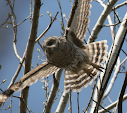
One of the early highlights of the day was the Osprey in the previous post. In addition to that I had the chance to observe four new species, three of which I got passable photos of, including the Swainson's Thrush above.
Not all birds were new, however, some just gave me better photo opportunities than I have had in the past. The Rock Wren above and Great Egret below were two such species. The Great Egret was a species that I observed for the first time in Colorado.

It was really a day of Egrets when looking out over the vegetation surrounding the lake. We kept passing groups of Snowy Egrets in numbers from four to six, and then near the end of the day saw a group of 20 all working through the weeds together. They made a good comparison with the Great Egrets who were far fewer in number.

I was glad for the accompaniment of a much more experienced birder, who was able to help me identify this Cassin's Vireo. The overall olive tinge is a strong field mark distinguishing it from the Plumbeous Vireo which is more gray.

It was really a day of Egrets when looking out over the vegetation surrounding the lake. We kept passing groups of Snowy Egrets in numbers from four to six, and then near the end of the day saw a group of 20 all working through the weeds together. They made a good comparison with the Great Egrets who were far fewer in number.

I was glad for the accompaniment of a much more experienced birder, who was able to help me identify this Cassin's Vireo. The overall olive tinge is a strong field mark distinguishing it from the Plumbeous Vireo which is more gray.
The Vireo wasn't the only Cassin's species I observed however. The two Kingbirds below are of the Cassin's species. We saw these mixed in with several Westerns in a group of passed sunflowers. In the field it was tough to be certain of the id, but after zooming in on the stills the overall gray head and upper breast were clear. That differs from the Western variety which has a lighter head and white on the breast. Because of the lighter head on the Western Kingbird, it has a more distinct eyeline. In contrast the Cassin's has a less distinct eyeline, but a distinctive white malar streak. It was a good lesson to learn. Later as we visited with some banders working further along I learned that in mid September most of the Westerns will depart and Cassin's Kingbirds will become the more common of the two until they complete their migration as well.

Along with the Cassin's Vireo, Kingbird, and Swainson's Thrush I added a group of Franklin's Gulls to my list, but while distinct through a scope they were just blurry specs on a fully zoomed photograph.

Along with the Cassin's Vireo, Kingbird, and Swainson's Thrush I added a group of Franklin's Gulls to my list, but while distinct through a scope they were just blurry specs on a fully zoomed photograph.
Counts are great fun, and as always birding with others is a good educational experience. If you don't get the chance to join one this fall think about clearing some time for a Christmas Bird Count in a few months. I am really looking forward to repeating those counts and being more of a contributor this time around.
2009 Count: 185
2009 Count: 185
Lifetime: 193



No comments:
Post a Comment